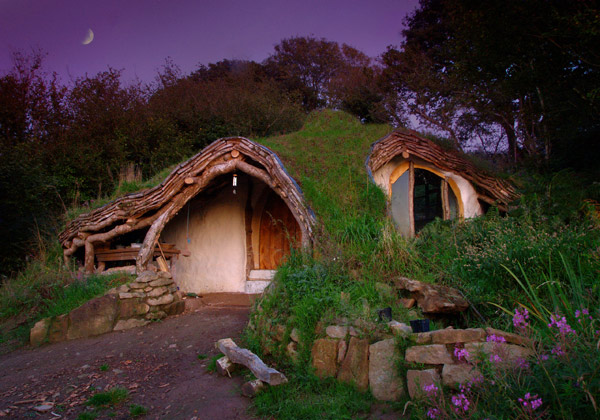 image from A Low-Impact Woodland Home
image from A Low-Impact Woodland HomeAlternative Housing Means Diversity
It might be more descriptive to refer to Low-Impact housing rather than Alternative. Low Impact also goes by Ecological, Factor Four, Green, Healthy, Low Emission, Passive, Zero Emission, etc. The main point is to lower the impact on the environment from site selection through the remainder of the house’s lifecycle. The finished home can take on any number of different looks depending on the building site and the combination of traditional and new technologies chosen for materials and construction.
Urban Low Impact
Paola Sassi is an architect in Wales who chose to showcase sustainability in her choice of building materials. As she put it in an article on the Homebuilding & Rennovation UK magazine site: “…I wanted to prove that it is possible to build a house in a city centre that is sustainable, comfortable and cheap to run.” Her design, situated among Victorian style houses in Cardiff features hemp as an insulator, veneered plywood interiors, triple glazed windows on one side and solar panels and has no heating system. Planning for the future and an eventual demolition, Sassi chose only materials that could be reused or recycled. The biggest learning curve for the contractors building the house was that a house without a heating system must be air tight and this required some do-overs during construction. In the end, though, the cost of maintaining her house is less than a quarter of what a standardly built house of the same size costs and it emits less than a quarter of a standard house’s CO2.
Choice of Materials
Depending on the chosen site, a host of alternative, low-impact materials and methods are available. Adobe is a historically used and still viable material. Bamboo is a sustainable material that’s being used in floors but has also served long and well for construction in tropical areas, though the result can be strikingly modern. Cob houses are built of earth and straw and have survived centuries. They require virtually no tools at all, since the buildings are literally sculpted by the builder. At first thought, cordwood wouldn’t seem to be that environmentally correct because of the use a large amount of wood. But the wood used is most often what is considered waste material and if a mortar other than cement could be used efficiently, cordwood building could be even more of an ecological choice than the rather art nouveau styles of lightweight concrete, which must still be produced by concrete plants where toxicity can be a concern for neighbors.
In most cases, the builder will probably choose to combine materials like adobe and cob to suit the site environment and make use of changes in technology and methodology that afford the best chance of success to make their vision a reality.
Strange Housing Materials
Some materials may not be the first things that come to mind when building a home, but here are some that have been tried anyway. In Australia, they’re looking at cardboard and in New Mexico an architect named Mike Reynolds is using rubber tires, dirt and aluminum cans. And aluminum cans is what one man used to replace the siding on his house, while another man went one step further to design an entire house out of aluminum.
Housing Materials of the Future
As sustainable materials building with an eye to complementing the environment rather than dominating it becomes more mainstream, we’re likely to see even more variety in the materials and methods available to builders. This trend is only likely to gain momentum as global warming and the scarcity of nonrenewable resources continue to make an impact. In the near future, building “green” may be such a standard that the term itself goes out of fashion. Like ridesharing, it’s an idea whose time is here.




No comments:
Post a Comment